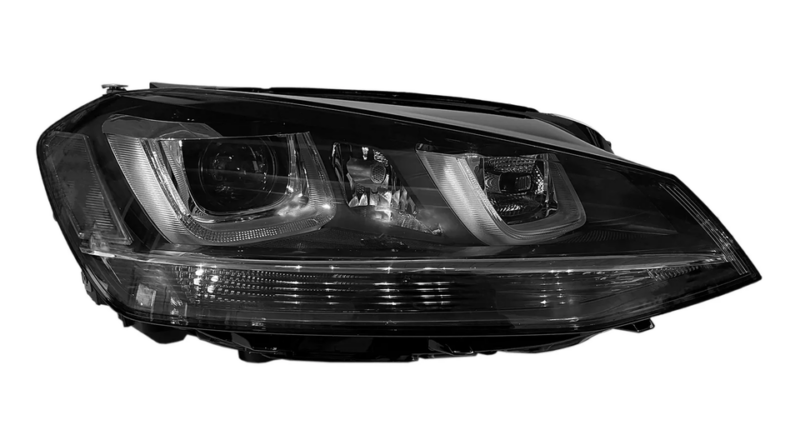A Guide What Are Xenon Headlights?
In this article, we’ll explore what are Xenon headlights are, how they work, their advantages and disadvantages, and considerations for those looking to upgrade. Xenon headlights, also known as High-Intensity Discharge (HID) headlights, have revolutionized automotive lighting with their superior brightness and energy efficiency. Commonly found in luxury and high-performance vehicles, Xenon headlights offer a range of benefits over traditional halogen bulbs.
What Are Xenon Headlights?
Xenon headlights utilize a gas-discharge process to produce light. Unlike traditional halogen headlights, which use a filament, Xenon lights generate light by passing an electric current through xenon gas. This process creates a bright, white-blue light that closely resembles natural daylight, improving night time visibility and safety.
How Do Xenon lights Work?
Xenon lights operate through a series of steps involving several key components:
- Ballast: This device regulates the electrical current and voltage needed to start and maintain the light.
- Igniter: The igniter generates a high-voltage pulse to ignite the xenon gas.
- Xenon Bulb: Once ignited, the xenon gas produces an intense white-blue light.
The process begins when the ballast sends a high-voltage current to the igniter, which then ignites the xenon gas inside the bulb. The electric arc created within the bulb emits a bright light that is then focused and directed by the headlight housing.
Benefits of Xenon
- Superior Brightness: Xenon lights are much brighter than halogen bulbs, providing better illumination of the road and surroundings.
- Energy Efficiency: They consume less power than halogen headlights, leading to improved fuel efficiency.
- Long Lifespan: Xenon bulbs last significantly longer than halogen bulbs, reducing the need for frequent replacements.
- Enhanced Visibility: The bright, white-blue light closely mimics daylight, reducing eye strain and improving visibility at night and in adverse weather conditions.
- Stylish Appearance: Xenon headlights give vehicles a modern and upscale look.
Xenon lights vs. Halogen lights
- Brightness: Xenon headlights are about three times brighter than halogen bulbs.
- Energy Efficiency: Xenon bulbs use less energy, leading to reduced fuel consumption.
- Lifespan: Xenon bulbs last much longer than halogen bulbs, often up to five times longer.
- Color Temperature: Xenon headlights produce a white-blue light, while halogen bulbs emit a yellowish light.
- Cost: Xenon headlights are more expensive initially but offer long-term savings due to their durability and efficiency.
Xenon vs. LED lights
- Brightness: Both Xenon and LED headlights are brighter than halogen, but LEDs are generally more efficient.
- Energy Efficiency: LEDs are more energy-efficient than Xenon headlights.
- Lifespan: LEDs typically last longer than Xenon bulbs.
- Warm-Up Time: Xenon lights require a few seconds to reach full brightness, while LEDs light up instantly.
- Cost: LEDs can be more expensive than Xenon headlights but offer better long-term value.
Disadvantages of Xenon lights
- Cost: Xenon headlights are more expensive to purchase and install compared to halogen bulbs.
- Warm-Up Time: They require a few seconds to reach full brightness.
- Complex Installation: Installing Xenon lights can be more complex and may require professional assistance.
- Glare: Xenon headlights can produce glare for oncoming drivers if not properly adjusted.
Installation of Xenon lights
While professional installation is recommended due to the complexity, here are the basic steps involved in installing Xenon lights:
- Choose the Right Kit: Ensure the Xenon light kit is compatible with your vehicle.
- Preparation: Gather necessary tools and ensure the vehicle is turned off.
- Remove Old Headlights: Access the headlight assembly and remove the existing bulbs.
- Install Ballasts and Igniters: Securely mount the ballasts and igniters in the engine bay.
- Install Xenon Bulbs: Carefully install the Xenon bulbs into the headlight housing.
- Connect Wiring: Connect the Xenon bulbs to the ballasts and igniters, ensuring proper connections.
- Adjust Beam Pattern: Properly adjust the beam pattern to avoid blinding oncoming traffic.
- Test the Lights: Turn on the headlights to ensure they are functioning correctly and make any necessary adjustments.
Xenon lights offer a range of benefits, including superior brightness, energy efficiency, and a long lifespan. They enhance visibility and safety, providing a modern look for vehicles. While they come with higher initial costs and some installation complexity, the advantages make them a popular choice for those seeking improved performance and aesthetics in automotive lighting. By understanding what Xenon lights are and how they work, you can make an informed decision about upgrading your vehicle’s lighting system.
Buying a used VW. Buying used vauxhall, BMW, Jaguar, Ford, Volvo, Range rover, Bentley, Aston Martin, Porsche, Ferrari, Lamborghini, Maserati, Hyundai, Tesla, Honda, Pagani

